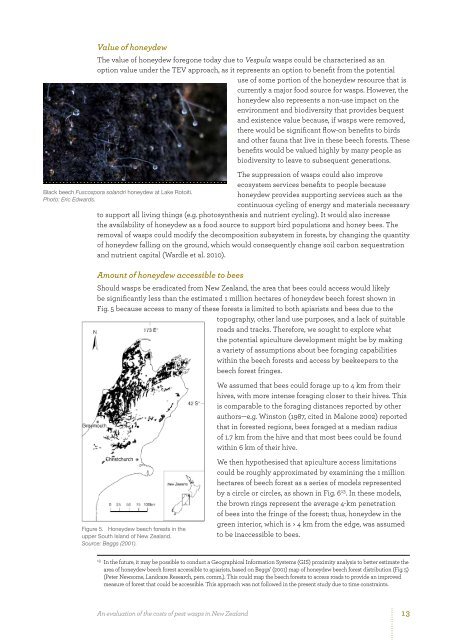evaluation-pest-wasps-nz
evaluation-pest-wasps-nz
evaluation-pest-wasps-nz
You also want an ePaper? Increase the reach of your titles
YUMPU automatically turns print PDFs into web optimized ePapers that Google loves.
Value of honeydewThe value of honeydew foregone today due to Vespula <strong>wasps</strong> could be characterised as anoption value under the TEV approach, as it represents an option to benefit from the potentialuse of some portion of the honeydew resource that iscurrently a major food source for <strong>wasps</strong>. However, thehoneydew also represents a non-use impact on theenvironment and biodiversity that provides bequestand existence value because, if <strong>wasps</strong> were removed,there would be significant flow-on benefits to birdsand other fauna that live in these beech forests. Thesebenefits would be valued highly by many people asbiodiversity to leave to subsequent generations.The suppression of <strong>wasps</strong> could also improveecosystem services benefits to people becausehoneydew provides supporting services such as thecontinuous cycling of energy and materials necessaryto support all living things (e.g. photosynthesis and nutrient cycling). It would also increasethe availability of honeydew as a food source to support bird populations and honey bees. Theremoval of <strong>wasps</strong> could modify the decomposition subsystem in forests, by changing the quantityof honeydew falling on the ground, which would consequently change soil carbon sequestrationand nutrient capital (Wardle et al. 2010).Black beech Fuscospora solandri honeydew at Lake Rotoiti.Photo: Eric Edwards.Amount of honeydew accessible to beesShould <strong>wasps</strong> be eradicated from New Zealand, the area that bees could access would likelyigure 5. Honeydew beech forests significantly in the less upper than the South estimated Island 1 million of New hectares of honeydew beech forest shown inealand.Fig. 5 because access to many of these forests is limited to both apiarists and bees due to thetopography, other land use purposes, and a lack of suitableroads and tracks. Therefore, we sought to explore whatthe potential apiculture development might be by makinga variety of assumptions about bee foraging capabilitieswithin the beech forests and access by beekeepers to thebeech forest fringes.Figure 5. Honeydew beech forests in theupper South Island of New Zealand.Source: Beggs (2001).We assumed that bees could forage up to 4 km from theirhives, with more intense foraging closer to their hives. Thisis comparable to the foraging distances reported by otherauthors—e.g. Winston (1987, cited in Malone 2002) reportedthat in forested regions, bees foraged at a median radiusof 1.7 km from the hive and that most bees could be foundwithin 6 km of their hive.We then hypothesised that apiculture access limitationscould be roughly approximated by examining the 1 millionhectares of beech forest as a series of models representedby a circle or circles, as shown in Fig. 6 13 . In these models,the brown rings represent the average 4-km penetrationof bees into the fringe of the forest; thus, honeydew in thegreen interior, which is > 4 km from the edge, was assumedto be inaccessible to bees.13In the future, it may be possible to conduct a Geographical Information Systems (GIS) proximity analysis to better estimate thearea of honeydew beech forest accessible to apiarists, based on Beggs’ (2001) map of honeydew beech forest distribution (Fig. 5)(Peter Newsome, Landcare Research, pers. comm.). This could map the beech forests to access roads to provide an improvedmeasure of forest that could be accessible. This approach was not followed in the present study due to time constraints.An <strong>evaluation</strong> of the costs of <strong>pest</strong> <strong>wasps</strong> in New Zealand13


